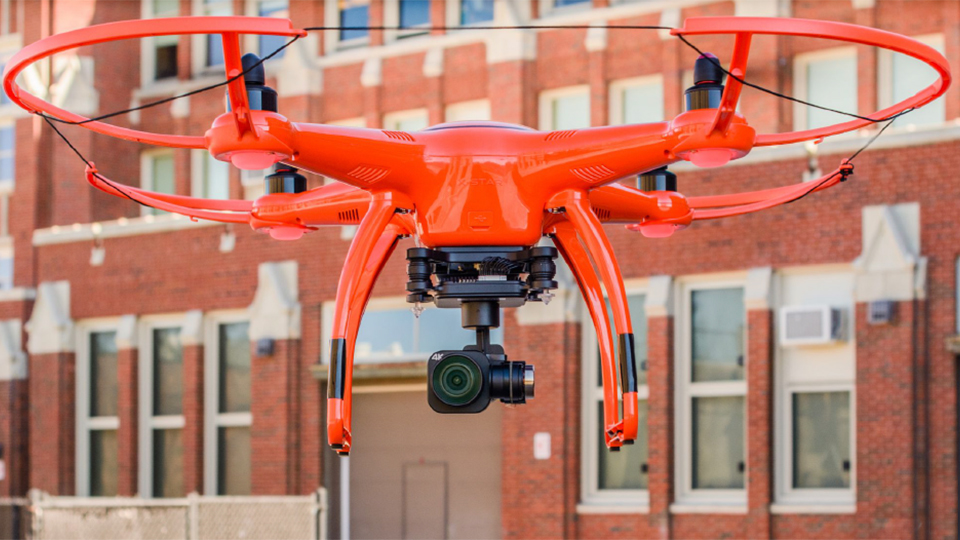The Phoenix Project: Rising from the Pentagon's Ashes
By Tom Inglesby
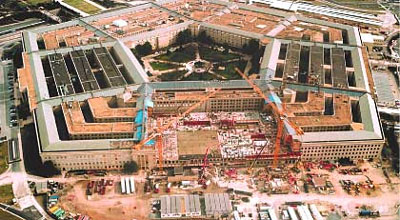 Photos courtesy of Masonry Arts, The U.S. Department of Defense, and the Pentagon Renovation Project |
Rich Bartram was in Ft. Worth, Texas on September 11, 2001. His work on the renovation of Wedge 1 of the Pentagon was over and Bartram, field management director for Masonry Arts, Bessemer, Ala., was starting another job. Joe Windsor and Ric Vignevic were to finish up a punchlist at the Virginia building prior to turning the job over to the government. That three-year project was finally finished.
Windsor and Vignevic were doing some work on a window that morning, and had to go to a local Home Depot for supplies. They left the Pentagon about 8 a.m. and got caught up walking the aisles, as most construction people do when they hit The Home, browsing around before heading back. Some trim nails, sandpaper, no hurry; that three-year project was finally finished.
Christopher Fromboluti, a principal of the architecture firm of Hellmuth, Obata & Kassabaum, was in his office across the Potomac River from the building that he had worked on since 1994. HOK was responsible for the design of the massive Pentagon Renovation (PenRen) project at the Pentagon's Wedge 1. His work on the project wasn't over, not by a long shot.
At 9:38 a.m., while Vignevic and Windsor were stuck in traffic on I-395, while Fromboluti and Bartram were having a second cup of coffee, American Airlines Flight 77 flew into history.
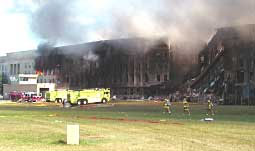 Hijacked Flight 77 tore into the Pentagon at approximately 350 miles per hour, tearing through three of the building's five concentric rings ? "E," "D," and "C" ? while exploding. It killed 125 Pentagon workers and 64 airline passengers and crew. The plane hit at a 45-degree angle, causing it to travel through both the newly renovated Wedge 1 and a portion of Wedge 2 that was awaiting renovation. About 2 million square feet were damaged by smoke, water, and flames that burned for two and a half days. Of this, 400,000 square feet were completely demolished and later replaced in the construction effort.
Hijacked Flight 77 tore into the Pentagon at approximately 350 miles per hour, tearing through three of the building's five concentric rings ? "E," "D," and "C" ? while exploding. It killed 125 Pentagon workers and 64 airline passengers and crew. The plane hit at a 45-degree angle, causing it to travel through both the newly renovated Wedge 1 and a portion of Wedge 2 that was awaiting renovation. About 2 million square feet were damaged by smoke, water, and flames that burned for two and a half days. Of this, 400,000 square feet were completely demolished and later replaced in the construction effort.
Lee Evey, program manager for the Pentagon renovation project, said that if the building had not been under restoration, there could have been 10,000 Defense employees in Wedges 1 and 2. Instead, there were only 4,600 workers in the 2 million square feet of offices. Some had just moved into new Wedge 1 offices while others were waiting to move out of Wedge 2.
"I knew Ric and Joey were there," Bartram recalls. "I went crazy until I got through to them about an hour after it happened, about 10:30 a.m. I was happy to hear that they were away from the job, out getting parts. They very well could have been right where the plane went in, in Corridor 4."
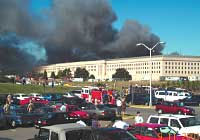 For roughly 35 minutes, the survivors in Wedge 1 and 2 made there way out of the building, fighting the choking smoke and acrid fumes, many crawling along the corridors seeking exits, stairs, any way to get out. During that time, the integrity of the renovated Wedge 1 walls gave them the time to move from floors three through five to the ground floor and the exits.
For roughly 35 minutes, the survivors in Wedge 1 and 2 made there way out of the building, fighting the choking smoke and acrid fumes, many crawling along the corridors seeking exits, stairs, any way to get out. During that time, the integrity of the renovated Wedge 1 walls gave them the time to move from floors three through five to the ground floor and the exits.
Army Col. Roy Wallace was in "C" Ring on the second floor just off Corridor 4. "We were on the phone in a conference call when we heard this loud explosion," Wallace told Jim Garamone of the American Forces Press Service. "It actually knocked us out of our seats. The ceiling collapsed and windows along the outer wall blew out toward the inside of the building. They must have been blast windows because they didn't splinter."
The smoke was so thick in the building that anyone trying to get out had to navigate by sound. "The smoke was black as pitch [with] noxious fumes, and it was rolling like a wave from the outer part of the building," Wallace remembers. Several people came out of the smoke and went past Wallace. "When we couldn't stand the smoke anymore, we went to the 4th corridor, at which time we saw an Army officer coming from the "E" Ring. He fell in front of us and wasn't moving. So five or six people and I picked him up and carried him toward the center courtyard."
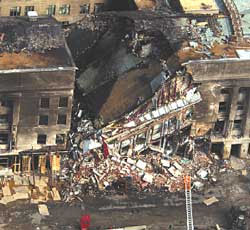 Wallace and others cordoned off the area where the smoke was too thick for people to pass. He and several other officers and NCOs then went to Corridor 5 to look for stragglers. The men had to duck into a bathroom and wet their T-shirts and place them over their mouths in order to breathe. The smoke grew so thick that they had to crawl along the floor. Wallace went along the "B" Ring knocking on doors and, when he got an answer, telling the people inside how to escape.
Wallace and others cordoned off the area where the smoke was too thick for people to pass. He and several other officers and NCOs then went to Corridor 5 to look for stragglers. The men had to duck into a bathroom and wet their T-shirts and place them over their mouths in order to breathe. The smoke grew so thick that they had to crawl along the floor. Wallace went along the "B" Ring knocking on doors and, when he got an answer, telling the people inside how to escape.
Bartram's concern for his men was obviously his top priority when he heard about the crash. Later, he heard about others he knew who were in the building that morning. "One pipe fitter that I know was walking down Corridor 4 toward where the plane came in. He was only about 50 feet down Corridor 4 when it hit. The shock wave and the blast threw him down the corridor. Miraculously, a machine room door that was always closed and locked suddenly opened. He hit the door, bounced inside the electrical room, up against the rack and got knocked out. He said he must have been out for about 20 to 30 seconds."
Bartram continues, "When he came to, he went to open the door to get out from inside the closet, and the door was so hot that he had to take his shirt and wrap it around the handle in order to open it. The corridor was full of black smoke. He got on his hands and knees and started crawling toward the roadway, called the A/E Drive, that runs between Rings "B" and "C." He was just choking from the fumes; he couldn't crawl fast enough. So, he got up and started running. He couldn't see anything, but he knew which direction he was going. Just when he got up, somebody grabbed him by the back of the shirt and pulled him out to the 'Drive' where there was fresh air."
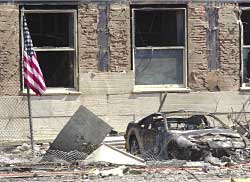 As we all remember, the events of September 11, 2001 caused the government to ground all air traffic throughout the country for several days. Bartram, in Ft. Worth, knew he had to get back to the Pentagon and help ? for years, the project had been his daily life. "I couldn't get a flight out but I had my truck with me so I drove 20 hours straight and got there about midnight Friday night/Saturday morning. About 1:30 in the morning I got together with the renovation team. That's when they asked if we could do the fa?ade, put the stone back, and I told them, 'Yes, of course.'
As we all remember, the events of September 11, 2001 caused the government to ground all air traffic throughout the country for several days. Bartram, in Ft. Worth, knew he had to get back to the Pentagon and help ? for years, the project had been his daily life. "I couldn't get a flight out but I had my truck with me so I drove 20 hours straight and got there about midnight Friday night/Saturday morning. About 1:30 in the morning I got together with the renovation team. That's when they asked if we could do the fa?ade, put the stone back, and I told them, 'Yes, of course.'
"That's how we got the contract," he adds. "Our executive vice president, Ken Hayes, flew in a couple days later and locked up the deal. We actually purchased the blocks out of the quarry and had drawings made of the stone and fabrication before we had a signature on a contract."
Immediately after the firefighters had the fire under control, the PenRen program manager, Lee Evey, started to plan the rebuilding of the Pentagon. With smoke still coming from the damaged section, someone suggested the new program be called The Phoenix Project, from the greek myth about the bird rising from the ashes. The name stuck. With a handshake commitment from everyone, the plan was agreed upon: E-ring at the point of impact would be ready for business as usual by September 11, 2002 ? one year to the day, 61 years from the groundbreaking of the original building in 1941.
Two names come up repeatedly when discussing the speed of the response to the attack: Lee Evey and Allyn Kilsheimer. According to Fromboluti, "Lee Evey is a 'can-do' guy. He was the project leader on PenRen and when the crash occurred, he knew that a special team was needed to get the building cleared, the damaged section demolished, and the reconstruction done as quickly as possible. He's the one that's kept all the government contractors in line, in a supportive role as opposed to an adversarial one."
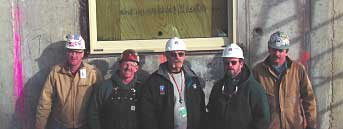 The Masonry Arts crew poses with the first blast window installed in The Phoenix Project area. From the left: James Coats, Michael Moore, Rich Bartram, Ric Vignevic, and Joe Windsor. |
Fromboluti remembers, "Evey asked, 'Who do you want to work on this project?' Kilsheimer submitted a list of those he thought could do the job. The Pentagon said okay and picked the team in a day."
"Kilsheimer comes to work at 1:30 every morning. If things aren't going right he yells and screams," Fromboluti says with a smile. "If people don't listen to him he goes to Evey and explains it and Evey says, 'Do it!'" Kilsheimer was on site late the morning of September 11 and worked through the night and into the next day and next night, doing the initial stabilization of the structure."
For weeks after the attack, Masonry Arts had workers on the site, helping with the cleanup and assisting forensic agents from the FBI to sift the debris. People like Isaac Peterson, a stonemason, and ironworkers Vignevic and Windsor labored at whatever work was necessary. Bartram was building his team even as Evey and Kilsheimer built theirs. Masons and ironworkers came from Alabama, Maryland and Virginia to help.
"There was a memorial held on October 11 for the people who were killed," Bartram notes. "On October 12, we started taking the stone off the building. We took down approximately 2,400 pieces of stone, a lot of which had melted aluminum from the plane embedded in it. We took it all down in about 13 days.
"While we were taking it down, they had already started the demolition on the building, tearing the rest of the structure down in the Phoenix area. After we had all the stone down, Mary Oehrlein, who calls the shots on how to clean and fix historic government buildings, gave us directions on cleaning the stone. We trucked all the stone over to the North parking lot where we separated and cleaned it according to her requirements." Oehrlein, of Mary Oehrlein Associates, Washington, DC, has also worked on the restoration of the Washington Monument.
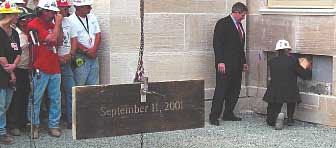 On June 11, 2002, a memorial piece of limestone from the damaged section was placed to cover a dedication capsule in the new wall. |
Fromboluti, the architect, was part of this team. "When we rebuilt Wedge 1, the original wall was masonry with a limestone fa?ade. We reinforced that wall with steel. Another big difference is that this is a cavity wall, whereas in the original construction the limestone was attached right to the masonry so there was no cavity. We had to redesign the limestone wall to look like the old, non-cavity wall. That presented quite a challenge."
Craig Morgan, a senior associate working with Fromboluti, adds, "We worked with Masonry Arts to get the details done right. Usually the architect does a bunch of drawings, the job goes out to bid, everybody gripes about it. Then you get shop drawings and you fight over it. That process takes a long time. This job was different. We all worked on it together. That's why it went so fast ? we're all on the same page."
They started pouring the Phoenix area on the southern corner. "They wanted the 'E' Ring done as fast as possible so we could put the blast windows in and get the stone process started as soon as possible," Bartram says. "That front wall was done three months earlier than anybody expected it to be done. When they were still pouring the last section of the 'E' Ring wall on the far North side, we were already up three or four floors with stone on the South side."
With all the trades gathered, with the speed of the Project at the forefront, the construction site started to take on the usual look of confusion. "When we first started, it was very difficult," admits Bartram. "The concrete crews were stripping forms, concrete trucks were coming and going, they had pump trucks set up in front of the building right in the center of the Phoenix area. Logistically, it was very difficult coordinating everything and moving around. Everyone wanted to occupy the same space at the same time."
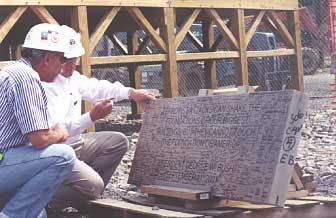 Mike Adelizzi (right), executive director of MCAA, signs the memorial stone for all MCAA members. With him is Rich Bartram of Masonry Arts. |
"He made all the decisions to get this thing rolling because the government wanted it back in business. To cut government red tape, we'd go to Allyn. We'd get an answer from him, sometimes within five minutes or at the latest within 24 hours. In many cases, we would be done by the time the paperwork came back from the government and the general contractor."
While the limestone that could be salvaged was cleaned, inspected and tested for integrity by Peterson, the architects were working with Oehrlein to find replacements for the units that had been damaged beyond use. Oehrlein is an architectural consultant, an expert on limestone and historic buildings. "She was a key part of the team," says Morgan. "Picking the right limestone was very important. We went out to Indiana three times to find the right stone. First trip, we just talked. On the second trip, we looked at the stone they were going to use and it was the wrong type. The three trips were key to getting it right."
It was the start of winter in Indiana limestone country and the quarries were already shut down. Luckily, the team found blocks already harvested and ready for cutting. "It was kind of wild," recalls Morgan. "We all went out to the fabricator, Bybee Stone, and we had to pick out the blocks to use. It's hard to tell what stone will look like when it's sitting there in a big block. That's where Mary Oehrlein helped us a lot."
Bybee had the stone, the experience, and the equipment to replicate the original limestone fa?ade units. Because the Pentagon is a National Historic Building, even repairs as extensive as The Phoenix Project had to conform to the original look while providing a stronger, more blast-resistant facility. The use of steel blade gang saws to cut the blocks gave them the same rough-hewn look as those installed in 1942, maintaining the historic image.
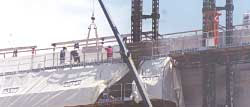 Stonemasons set the top course of limestone working from a Fraco mast climbing scaffold. Fraco, a Canadian company, has been proud of its contribution to the rebuilding of the Pentagon, even using this project as the focus of its advertising. People and companies like Fraco from around the world have been pitching in to help after September 11. |
Having cut the stone from 60-year-old drawings, some of it needed onsite adjustment. Here, trimming the stone to fit, the edges were not as critical from a historical standpoint so modern diamond blades from World Diamond Source (WDS), Pompano Beach, Fla. were used in equally modern saws. Matt Shrater, regional sales manager of WDS for Virginia comments, "We were honored to provide the blades they used on this important project. It's a small contribution to help the Masonry Arts crew get the job done quickly and properly. It made us all feel like we, too, were part of the team."
Pete Machado, a mason from R. Bratti, found some of the old techniques were still being required. "We used the old stone in the first section. Some of it was in pretty bad shape. We were setting it with a cold bed of mortar, something we're not used to doing anymore. That technique has pretty much been phased out of new construction."
Machado felt the project was being carefully supervised. "There were plenty of people to inspect what we were doing ? from the general contractor to the government to the historical society. There was always someone watching very closely what you were doing. Most of us aren't used to that kind of scrutiny."
Even with all the over-the-shoulder watching, his crew completed their work in record time. "It was pretty exciting," he admits. "Everybody worked a lot of hard hours, but there was always a lot of cooperation. There's usually more bickering on jobs. This one was all teamwork."
 By early June 2002, the exterior was done. |
At a press conference that day, Evey attributed the project's speed to the workers' personal motivation and dedication. "People don't really pay that much attention to what their title is, what their job is, what they've been specifically told to do, or what the normal constraints are in the way they operate," he said. "Everyone's there to make that project successful. They pitch in. They work. They help. They support one another and it's been very effective."
On September 11, 2002 the "E" Ring offices will be back in business. That's been the plan from Day One of The Phoenix Project. As Fromboluti says, "They will have people at their desks looking out the new blast windows at the ceremony going on below. The important thing is, the stone will be on the "E' Ring exterior and the building will look just like it did on September 10, 2001. That's because of the work of the crews from Masonry Arts and R. Bratti did under pressure even more intense than that of 1942."
All Mason Contractor Association of America members and their employees salute Masonry Arts and their subcontractors for the work they did on The Phoenix Project. As stonemason Isaac Peterson said, "It's an honor to be involved in something that's going to show the world people can put a hole in our life, but we can put it back together quickly and do it right. It's something that I can do for my country that I know how to do."
About the Author
Tom Inglesby is a San Diego-based freelance writer whose work has appeared in numerous online and print publications. He is the winner of the Construction Writers Association's 2002 Boger Award for Special Reports.









